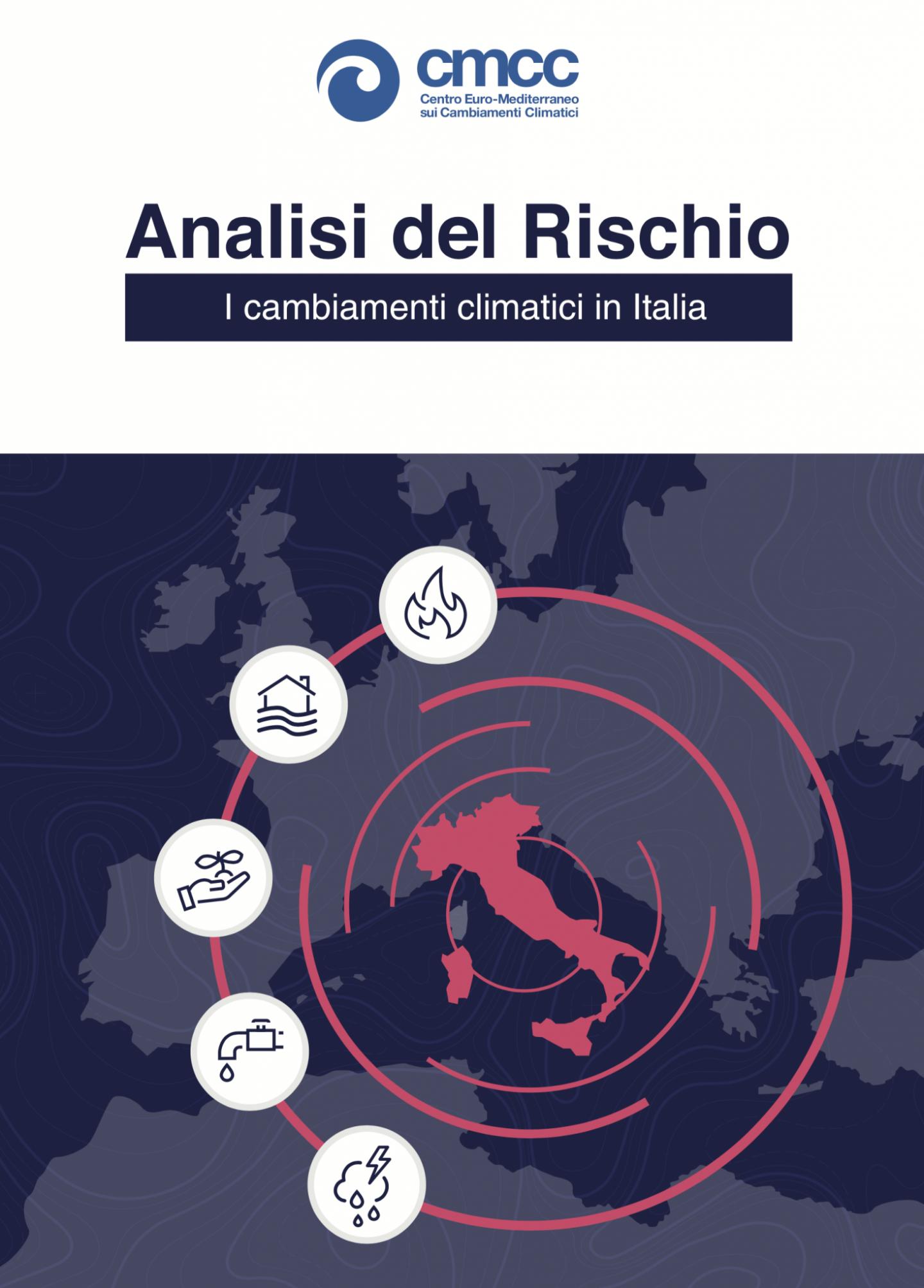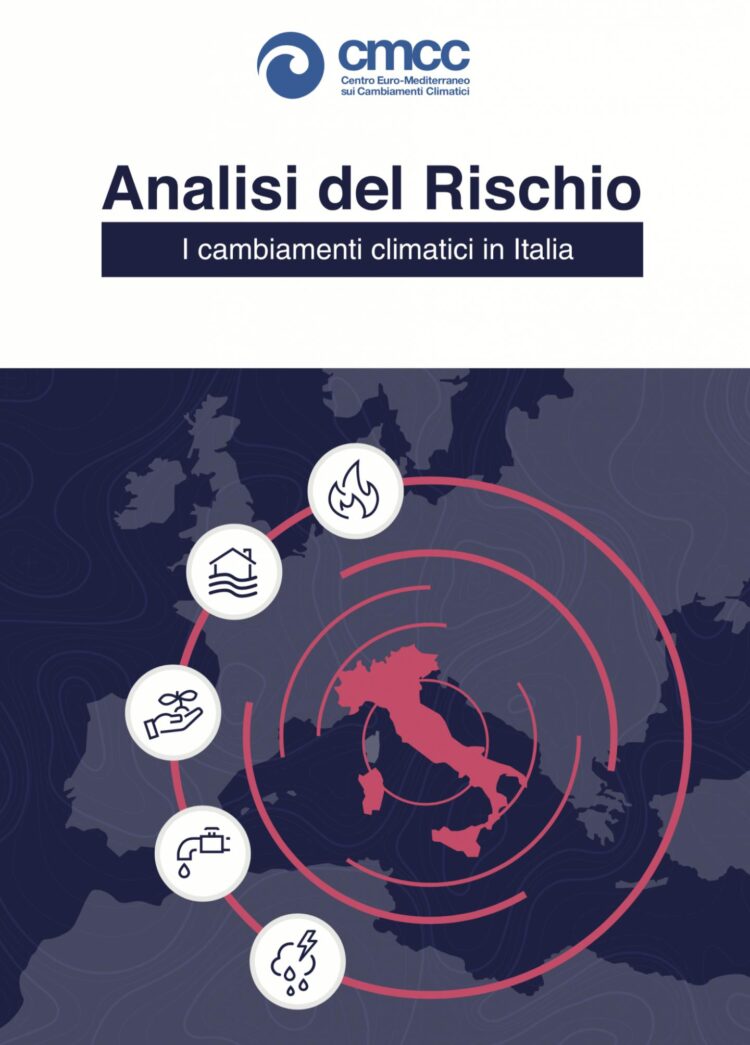
Credit: Fondazione CMCC
It could be worth up to 8% of GDP per capita, exacerbate the differences between north and south, between society’s rich and poor, as well as affect a number of Italy’s strategic sectors: climate change is a risk accelerator for many aspects of both the economy and society. The report, “Analisi del rischio. I cambiamenti climatici in Italia – Risk Analysis. Climate Change in Italy” has been published. Realized by the CMCC Foundation, Euro-Mediterranean Center on Climate Change, it is the first integrated analysis of climate risk in Italy. A document that bases itself on climate predictions for the coming years whilst focusing on specific sectors so as to provide information on what to expect from the future. It is a valuable support tool for concrete resilience and sustainable development strategies.
Risks associated with climate change affect all Italian regions and their economic sectors. Despite contrasts, with different areas being affected in different ways, there are no regions that can be considered immune from climate risks, which have already increased in recent years, in particular when considering extreme events.
The analysis carried out by the CMCC Foundation starts from climate scenarios that, through an advanced use of high-resolution climate models applied to the study of the Italian context, provide information on Italy’s future climate. This information is then applied to risk analysis for a number of sectors of the Italian socio-economic system. What emerges is a framework where, in the coming decades, risk grows in many areas with significant economic and financial costs for the country. Furthermore, the impacts will affect disadvantaged members of society more severely and also involves all sectors, not least of which infrastructure, agriculture and tourism.
Risk, scientific knowledge and response strategies
“This report contains the most up to date and advanced knowledge of the impacts and integrated risk analysis of climate change in Italy”, explains Donatella Spano, member of the CMCC Foundation and professor at the University of Sassari, who coordinated the thirty authors whose five chapters make up the research study. “Analysis of risks and their effects on environmental, natural, social and economic capital allow us to take response options identified by scientific research into account and develop integrated and sustainable management plans for the Italy, enhancing specific features, peculiarities and competences of the different territorial contexts”, continues Spano. “This knowledge is the result of innovative research, networking between the universities that contribute to the CMCC Foundation’s work, and international collaborations. It is also the product of top-level computing infrastructure at a global level. Putting all these aspects together in a multidisciplinary research perspective is a scientific community endeavour, the results of which are at the service of society and produce knowledge that benefits the entire country.”
“The challenge of risk connected to climate change – concludes Donatella Spano – starts from scientific knowledge and integrates adaptation and the solutions needed to face risks, in all phases of the decision-making processes including public policies, investment programs and the planning of public expenditure, so as to guarantee sustainable development at all territorial and governance levels.”
The report addresses the issues summarized below and is accompanied by a series of key messages, infographics and an executive summary that facilitates the reading and use of the report (available at this link).
Italy’s expected climate. The different climate models used concur in evaluating an increase in temperature of up to 2°C in the period 2021-2050 (compared to the period 1981-2010). In the worst-case scenario, the temperature increase may reach 5°C. Summer precipitation decreases in the central and southern regions, whereas intense precipitation events increase. In all scenarios, the number of hot days and periods without rain increases. The consequences of climate change on the marine and coastal environment will have an impact on coastal “ecosystem goods and services” that sustain socioeconomic systems through the provision of food and climate regulation services. (See the infographic).
Aggregate risk for Italy. Adaptation capacity and resilience are themes of concern for the entire Italian region, from north to south. Although the northern regions are richer and more developed, they are not exempt from climate change impacts, nor are they more prepared to face them. As for extreme events, the probability of risk has increased by 9% in the last twenty years in Italy.
Economic costs, tools and financial resources. The costs of climate change impacts in Italy increase exponentially as temperatures rise in the different scenarios, with values ranging between 0.5% and 8% of GDP by the end of the century. Climate change increases economic inequality between regions. All sectors of the Italian economy are negatively affected by climate change. However, the greatest losses concern the country’s networks and infrastructure, as well as the agricultural and the tourism sector, in both summer and winter. Climate change will require sizeable investments and represents an opportunity for sustainable development, which is recognized by the European Green Deal as the only possible development model for the future. Today is the best moment for new ways of doing business and for new ways of sustainable land management to become part of the know-how of companies and of public, local and national bodies. (See the infographic)
Cities and urban environment. Children, the elderly, the disabled and the most vulnerable members of society will be those who suffer the most from the increase in average and extreme temperatures, the greater frequency (and duration) of heat waves and intense precipitation events. Indeed, we expect an increase in mortality due to ischemic heart diseases, strokes, nephropathy and metabolic disorders due to thermal stress, and an increase in respiratory diseases due to the link between phenomena related to temperature rise in the urban environment (heat islands) and concentrations of ozone (O3) and fine dust (PM10). (See the infographic)
Geo-hydrological risk. From the combined analysis of anthropogenic factors and climatic scenarios, the worsening of an already very complex situation is expected. Rising temperatures and an increase in localized precipitation phenomena play an important role in exacerbating risks. For the former, melting snow, ice and permafrost indicates that the areas most affected by variations in magnitude and seasonality of instability phenomena are the Alpine and Apennine regions. For the latter, intense precipitations contribute to a further increase in the hydraulic risk for small basins and the risk associated with superficial landslides in areas with higher permeability soils. (See the infographic)
Water resources. Most of the impacts of climate change on water resources envisage a reduction in the quantity of both surface water and groundwater in almost all semi-arid regions, with a consequent increase in risks for Italy’s sustainable development. The expected changes in climate (drought, extreme events and changes in the rainfall regime, reduction in the flow rate), entail risks for water quality and availability. The most relevant risks for water availability are linked to high competition between sectors (civil, agricultural, industrial, environmental, energy production), which worsens in the hot season when resources are scarce and demand increases (for example for agricultural needs and tourism). (See infographic)
Agriculture. Agricultural systems may suffer from increased production variability, with a tendency towards yield reduction for many cultivated species, accompanied by a probable decrease in the qualitative characteristics of the produce. However, impacts are vary significantly depending on the geographical area and specific crops in question. Negative impacts are also expected for the livestock sector, with both direct and indirect impacts on farmed animals and consequent repercussions on the quality and quantity of production. (See infographic)
Wildfires. Rising temperatures, reduction in average annual precipitation, and greater frequency of extreme weather events such as heat waves and drought will interact with the effects of abandonment of cultivated areas, pastures and areas that used to be managed forests, a strong exodus towards cities and coastal areas, and increasingly efficient monitoring, prevention and active control activities. Climate change is expected to further exacerbate specific components of fire risk, resulting in impacts on vulnerable people, assets and ecosystems in the most vulnerable areas. Increases in the danger of wildfires, shift in altitudes that are considered vulnerable areas, lengthening of the fire season and an increase in extremely dangerous days are expected. This may translate into an increase in burnt areas, with a consequent increase in greenhouse gas emissions and particulate matter, with impacts on human health and the carbon cycle. (See infographic)
Risk Analysis. Climate Change in Italy
Spano D., Mereu V., Bacciu V., Marras S., Trabucco A., Adinolfi M., Barbato G., Bosello F., Breil M., Coppini G., Essenfelder A., Galluccio G., Lovato T., Marzi S., Masina S., Mercogliano P., Mysiak J., Noce S., Pal J., Reder A., Rianna G., Rizzo A., Santini M., Sini E., Staccione A., Villani V., Zavatarelli M., 2020. “Risk Analysis. Climate Change in Italy”.
DOI: 10.25424/cmcc/analisi_del_rischio
All material available at the following link: https:/
Media Contact
Mauro Buonocore
[email protected]
Original Source
https:/
Related Journal Article
http://dx.





